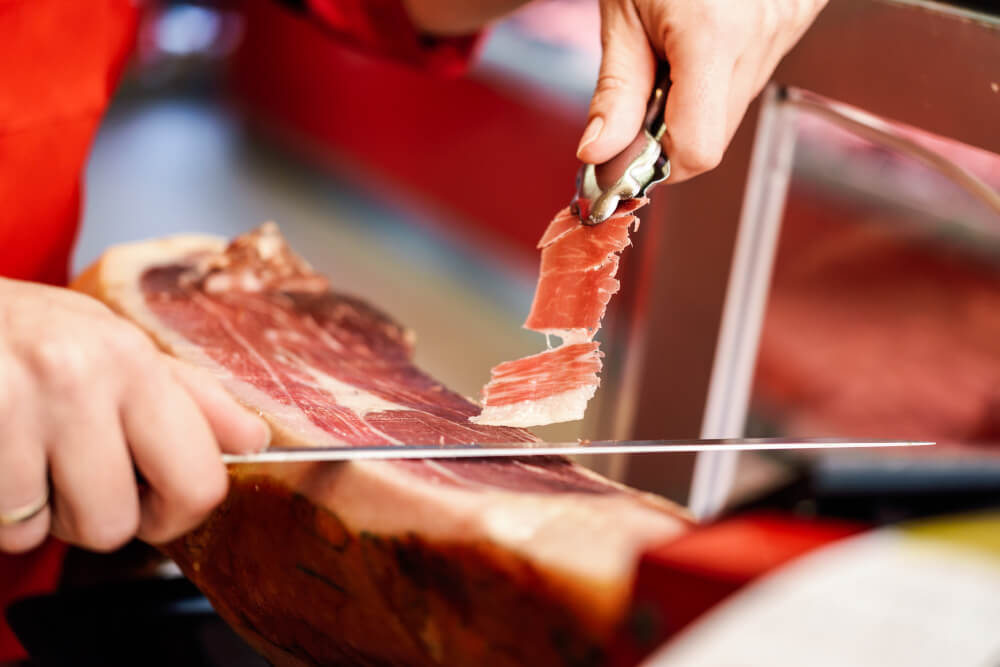The art of slicing jamón is a skill that can transform a good gastronomic experience into an extraordinary one. It’s not just about obtaining thin slices of jamón, but also about enhancing its flavor and texture. Proper slicing allows you to fully enjoy the nuances and quality of this cherished product. In Jamón Experience, we will explore the necessary tips and tricks to slice jamón like an expert, from preparation to different slicing techniques.
Ham Preparation and Utensils
Before starting to slice, it is essential to ensure that you have all the necessary utensils and that the jamón is properly prepared. You will need a jamón stand, a long and flexible jamón knife, a short and strong knife for cleaning and boning, and a sharpening steel to maintain the knife’s edge. Place the piece on the jamón stand with the hoof facing up if you will consume it in a short period, or facing down if it will be consumed more slowly.


The Right Knife
Choosing the right knife is crucial. The jamón knife should be long, thin, and flexible to allow precise and thin cuts. Keeping the knife sharp is essential to avoid tearing the meat and to achieve uniform slices. Use the sharpening steel regularly during slicing to keep the knife sharp.
Start with Cleaning the jamón
The initial cleaning of the jamón is an important step to ensure that the first slices are free of impurities. Use the short knife to remove the rind and excess yellow fat from the area you are going to cut. This fat can have a rancid taste and affect the tasting experience. Leave a thin layer of white fat, as it provides flavor and juiciness to the slices.
Types of Cuts
There are different slicing techniques depending on the area of the jamón and the occasion. Knowing these techniques will allow you to enjoy the different textures and flavors that the jamón offers.
Freehand slicing
Freehand slicing is the most traditional technique and allows for thin and translucent slices. This method is mainly used on the “maza,” the juiciest and most marbled part of the jamón. Make long and even cuts, moving the knife in a gentle back-and-forth motion to avoid tearing the meat. The ideal slice should be so thin that it is almost see-through.
Cubed Cut
The cubed cut is used to make the most of the parts closest to the bone, where it is difficult to obtain thin slices. This technique is perfect for preparing tapas and cooked dishes. With the short knife, cut the meat into small, even cubes, ensuring that each piece has a portion of fat to maintain the characteristic flavor of the jamón.
Presentation and Storage
The presentation of the jamón is almost as important as the slicing itself. Arrange the slices on a plate in an orderly manner, slightly overlapping them, to highlight their texture and color. A good plating enhances the tasting experience and makes the ham even more appetizing. If you don’t consume all the jamón at once, cover it with a clean cotton cloth or plastic wrap to prevent it from drying out. Store the ham in a cool, dry place, never in the refrigerator, to maintain its optimal flavor and texture. Remember that the “enemies” of a jamón piece are the light and oxygen.
Additional Tips
Practice makes perfect. Don’t be discouraged if your cuts are not perfect at first. With time and practice, you will improve your technique and enjoy the process of slicing and serving jamón even more. Additionally, make sure to rotate the jamón on the stand as you slice to make the most of each part. Finally, don’t forget to enjoy the process and share it with friends and family, as slicing jamón is a social activity that brings people together around a good plate.


Slicing jamón is a skill that combines technique and passion. From preparing the utensils to the final presentation, each step is important to ensure an unforgettable gastronomic experience. By following these tips and tricks, you can slice jamón like a true professional and enjoy all the subtleties that this exquisite product has to offer. Whether for a special occasion or to enjoy at home, mastering the art of slicing jamón will allow you to fully appreciate one of the greatest treasures of Spanish cuisine.

